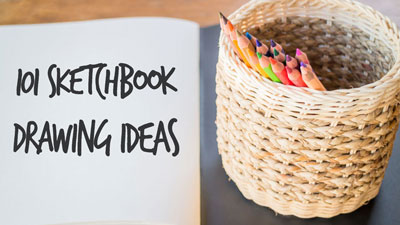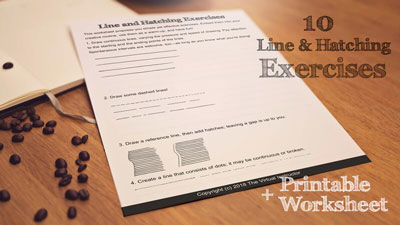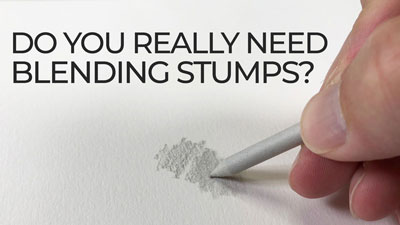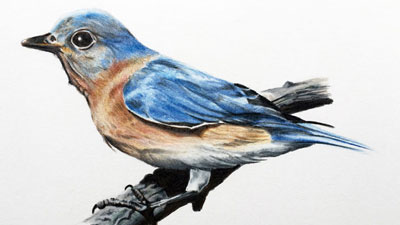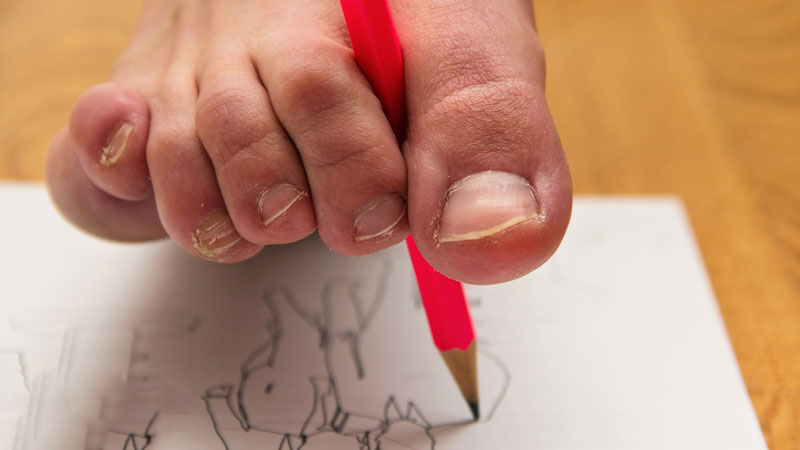
Developing your drawing skills requires practice. Most of the time practicing drawing is fun, but sometimes it can become a task. Why not make it an adventure by trying something new.
Here are a few things that you can try in your drawings (or practice sessions) to make things a little more exciting…
1. Try a New Medium
We’ll start with the most obvious thing you can try and that’s a new medium. Are all of your drawings in the same medium? If so, why not try a different one. If you typically only draw with graphite, why not try a few drawings with charcoal or pen and ink? How about colored pencils?
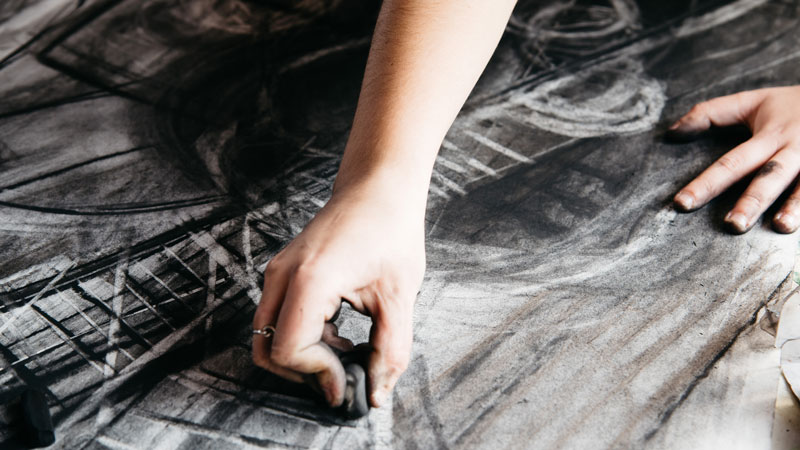
As I entered art school, I considered myself to be a “black and white” artist only. I preferred to use ink or graphite and I would tell people that color didn’t interest me. The reality is that I was a little afraid of color and I didn’t fully understand the full potential of it.
I learned that I loved color, but only after I was forced to use it. I learned that colored pencils were a wonderful medium and they quickly became one of my favorites. I wish I would have learned these things earlier.
See also: It’s Time to Try a New Medium
If you insist on trying and using only one medium, you may be missing out on a lot. So try a new medium – it may become your favorite. But you’ll never know unless you try.
2. Try a New Surface
Sometimes the drawing surface is an afterthought. In fact if you’re a beginner, you may not even think about it too much at all. But the surface is important and the one in which you choose to work influences how your medium behaves.
Of course, the world of drawing papers and surface is vast and not all are created equal. Like trying a new medium, trying a new surface may open a new world to you. You may find a new surface that you just fall in love with.
Experienced artists are devoted as much to their surfaces as they are to the mediums that they use. They know how much the surfaces matters to their success.
I still remember the first time I used Bristol paper for pen and ink drawing. It made a lasting impression – as if a new realm of possibilities had been opened up to me. Yes, a paper can have that strong of an impression.
So why not try a new surface? Have you ever worked on toned paper? What about charcoal paper, which features a laid pattern? Or perhaps, Stonehenge paper – which is made of 100% cotton?
See also: All About Drawing Papers
3. Explore a Different Subject
Is there a subject that intimidates you? Is there something that you avoid drawing when you can? If you answered “yes”, then it’s time to face that subject head-on.
Perhaps portraits intimidate you. If they do, commit yourself to drawing three different portraits. Watch how you improve with each one. By the time you’ve drawn the third one, you won’t be so intimidated by them any more. In fact, you may even discover that you love drawing portraits and wonder what kept you from them for so long.
4. Draw with Non-traditional Drawing Tools
Who says we have to use pens and pencils to make marks? Why not grab a bit of ink and try making marks with other things. You can get as creative as you wish, but here a few substitutes you may want to try…
Draw with Sticks
Why draw with the same old tools? Ditch those pens, pencils, and brushes for a day and give sticks a try. Surprisingly, using non traditional drawing tools can produce beautiful results. Grab a couple sticks (free) and some ink (not free) and make some interesting marks.
Often times, we can become too rigid with our drawings which can lead to stiff, overworked imagery. When you allow yourself a bit more freedom to make organic marks, the results can be quite cool.
A stick can make a variety of marks that just can’t be duplicated with pen or pencil.
Here’s a quick sketch that was created using only sticks and ink…
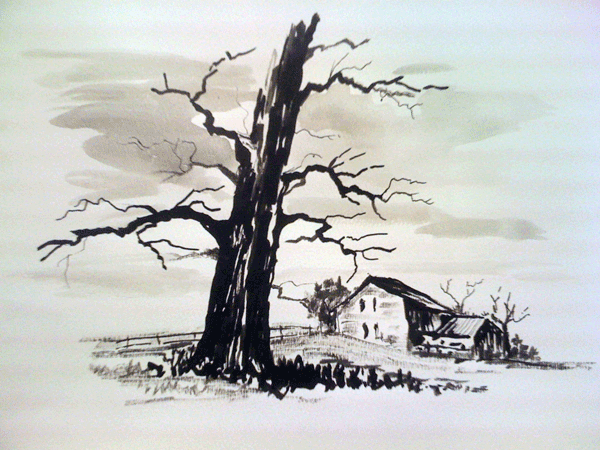
Sketch with Rocks
While you’re out picking up sticks, be sure to pick up a few rocks and stones too. Dip them in ink and make marks on larger sheets of paper. Create a looser drawing or roll the rocks over the surface while loaded with ink to create a non-objective experimental drawing. Let your creativity go wild.
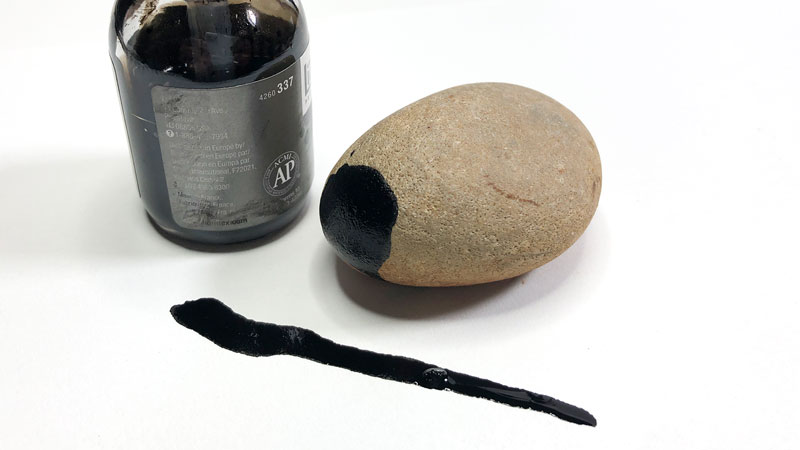
Paint with a Feather
Grab a nice long feather at the craft store and use the softer side as a mark making tool. Gently dip the end of the feather into a little ink on a plate and brush the feather over the drawing surface. See how many textures you can create.
5. Think Outside of the Box
Students at Rutgers University Roger Mason School of Art created machines to create repetitive marks. The intent was to create machines to make marks that humans couldn’t normally make. Another part of the exercise was the creation of guitars made of cardboard.
The instructor of the class, Jeff Thompson, would play “cheesy” metal music at the end of class, and students would strum their guitars with pencils.
The intent was to show students that using deliberate lines is not the only way to draw, and that loose lines are effective as well.
6. Use Your Feet
Go ahead and put that pencil between your toes and try to create a drawing from observation with your feet. Hint: Sit in a chair and tape the paper to the ground. You may be surprised at the range of lines that you make. You may be really surprised how much your drawing resembles what your subject.
With this exercise, your eyes are so far away from the drawing surface that it forces you to see your drawing in a different way. There’s no leaning in for a closer look here.
7. Draw with Your Non-Dominant Hand
This exercise is related to drawing with your feet. If you’re right handed, put the pencil in your left hand and draw from observation. Again, you might be pleasantly surprised at how much you are able to record what you see.
It will be a real challenge at first, but you’ll likely find that you actually spend more time looking at your subject. This leads to deeper observation, which ultimately leads to greater accuracy in your drawings.
Conclusion
So what not try something new in your drawings? Don’t be afraid of something that you’ve never tried before. As we’ve seen here, trying something new not only spices things up but it may also open some new artistic doors and inspire you in new ways. But you’ll never know if you’re not willing to try something new.
If so, join over 36,000 others that receive our newsletter with new drawing and painting lessons. Plus, check out three of our course videos and ebooks for free.

